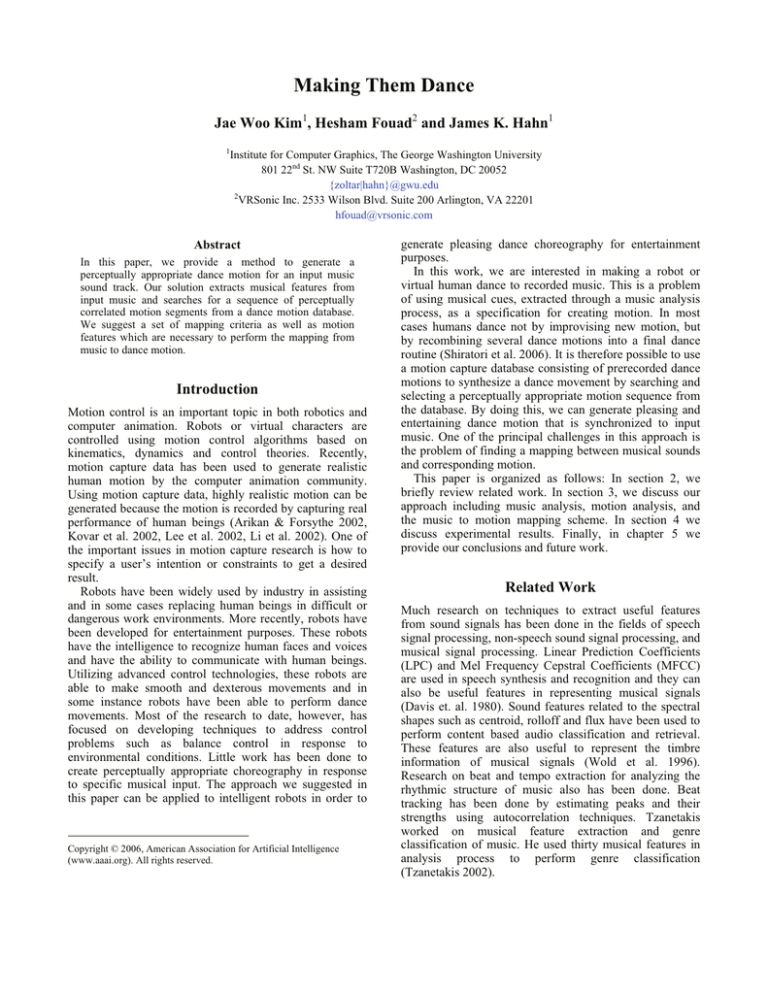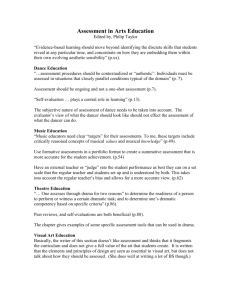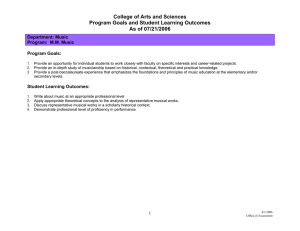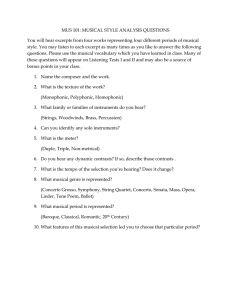
Making Them Dance
Jae Woo Kim1, Hesham Fouad2 and James K. Hahn1
1
Institute for Computer Graphics, The George Washington University
801 22nd St. NW Suite T720B Washington, DC 20052
{zoltar|hahn}@gwu.edu
2
VRSonic Inc. 2533 Wilson Blvd. Suite 200 Arlington, VA 22201
hfouad@vrsonic.com
Abstract
In this paper, we provide a method to generate a
perceptually appropriate dance motion for an input music
sound track. Our solution extracts musical features from
input music and searches for a sequence of perceptually
correlated motion segments from a dance motion database.
We suggest a set of mapping criteria as well as motion
features which are necessary to perform the mapping from
music to dance motion.
Introduction
Motion control is an important topic in both robotics and
computer animation. Robots or virtual characters are
controlled using motion control algorithms based on
kinematics, dynamics and control theories. Recently,
motion capture data has been used to generate realistic
human motion by the computer animation community.
Using motion capture data, highly realistic motion can be
generated because the motion is recorded by capturing real
performance of human beings (Arikan & Forsythe 2002,
Kovar et al. 2002, Lee et al. 2002, Li et al. 2002). One of
the important issues in motion capture research is how to
specify a user’s intention or constraints to get a desired
result.
Robots have been widely used by industry in assisting
and in some cases replacing human beings in difficult or
dangerous work environments. More recently, robots have
been developed for entertainment purposes. These robots
have the intelligence to recognize human faces and voices
and have the ability to communicate with human beings.
Utilizing advanced control technologies, these robots are
able to make smooth and dexterous movements and in
some instance robots have been able to perform dance
movements. Most of the research to date, however, has
focused on developing techniques to address control
problems such as balance control in response to
environmental conditions. Little work has been done to
create perceptually appropriate choreography in response
to specific musical input. The approach we suggested in
this paper can be applied to intelligent robots in order to
Copyright © 2006, American Association for Artificial Intelligence
(www.aaai.org). All rights reserved.
generate pleasing dance choreography for entertainment
purposes.
In this work, we are interested in making a robot or
virtual human dance to recorded music. This is a problem
of using musical cues, extracted through a music analysis
process, as a specification for creating motion. In most
cases humans dance not by improvising new motion, but
by recombining several dance motions into a final dance
routine (Shiratori et al. 2006). It is therefore possible to use
a motion capture database consisting of prerecorded dance
motions to synthesize a dance movement by searching and
selecting a perceptually appropriate motion sequence from
the database. By doing this, we can generate pleasing and
entertaining dance motion that is synchronized to input
music. One of the principal challenges in this approach is
the problem of finding a mapping between musical sounds
and corresponding motion.
This paper is organized as follows: In section 2, we
briefly review related work. In section 3, we discuss our
approach including music analysis, motion analysis, and
the music to motion mapping scheme. In section 4 we
discuss experimental results. Finally, in chapter 5 we
provide our conclusions and future work.
Related Work
Much research on techniques to extract useful features
from sound signals has been done in the fields of speech
signal processing, non-speech sound signal processing, and
musical signal processing. Linear Prediction Coefficients
(LPC) and Mel Frequency Cepstral Coefficients (MFCC)
are used in speech synthesis and recognition and they can
also be useful features in representing musical signals
(Davis et. al. 1980). Sound features related to the spectral
shapes such as centroid, rolloff and flux have been used to
perform content based audio classification and retrieval.
These features are also useful to represent the timbre
information of musical signals (Wold et al. 1996).
Research on beat and tempo extraction for analyzing the
rhythmic structure of music also has been done. Beat
tracking has been done by estimating peaks and their
strengths using autocorrelation techniques. Tzanetakis
worked on musical feature extraction and genre
classification of music. He used thirty musical features in
analysis process to perform genre classification
(Tzanetakis 2002).
Motion capture data are widely used in generating
realistic motion because they guarantee the realism of the
motion. Using stored motion data, motion graph techniques
have been used to generate new sequences of motion by
stitching many small motion segments according to input
specifications and motion constraints. Motion constraints
are specified as a set of key character poses, a path traveled
by the character, or a user’s motions in front of a video
camera (Arikan & Forsythe 2002, Kovar et al. 2002, Lee et
al. 2002, Li et al. 2002).
There have been several research efforts focused on
generating motion based on input music. Cardle et al.
extracted musical features from raw MIDI data as well as
an analog rendition of the MIDI soundtrack and then
applied different motion editing operations, such as motion
signal processing, infinite impulse response (IIR) filters,
and stochastic noise functions to alter the given motion
data according to the musical features. (Cardle et al. 2002)
Shiratori et al. suggested a technique to synthesize a
dance performance that is perceptually matched to input
music. To perform the mapping between musical features
to motion features, they extracted musical rhythm,
structure and intensity and motion rhythm and intensity.
Finally they synthesized a dance performance by matching
the rhythm and intensity between music and motion. The
framework of their solution is similar to ours, but in our
work we used many more musical features and defined
several useful motion features to improve the mapping
process. Also our mapping scheme has more criteria which
can lead the mapping process to generate more pleasing
and natural results. (Shiratori et al. 2006)
Musical analysis is carried out on musical segments. The
size of each segment is based on musical beat information
where each segment consists of sixteen beats. Once feature
extraction is performed on all segments, the segments are
clustered into n clusters using a k-means clustering
algorithm where the number of clusters n is given by the
user. The ideal number of clusters used in the analysis
process is related to the number of distinct patterns found
in the music. Fig 1 contains a workflow depiction of this
process: Input music is segmented into segments at every
sixteen beats. For each segment thirty features are
extracted resulting in musical feature vector. Each segment
is clustered into n clusters using the k-means clustering
algorithm based on the distance among the musical feature
vectors of each segment. A cluster consists of a set of
musical segments sharing common musical features. Using
observational analysis we have been able to validate that
indeed perceptually similar segments are placed in the
same cluster. Finally, once the musical segments are
assigned to clusters, each musical segment is labeled
according to its owning cluster resulting in a symbolic
representation of the musical piece such as
“DCBECEC…”. This sequence represents the global
repeating patterns in the music.
Music Driven Dance Motion Generation
In our approach, musical analysis as well as motion
analysis processes are used to extract useful information
from both the input musical data and a set of motion clips
in a motion capture database consisting of a variety of
recorded dance motions. The musical analysis process
extracts thirty musical features including beat, pitch and
timbre information. It also analyzes the global structure of
input music using a clustering algorithm. Motion analysis
extracts three motion features including motion intensity,
span, and density which represent the characteristics of the
dance motion. Finally mapping is performed between the
musical and motion features using a novel mapping
algorithm described below.
Fig. 1 Music Analysis
Motion Analysis
In this section we will discuss the motion representation
used for motion analysis and we will define three motion
features useful in representing the properties of motion.
Music Analysis
The musical analysis process extracts thirty separate
features categorized into three parts: beat, pitch and timbre
information. In order to produce a perceptually appropriate
mapping between music and motion, the extracted musical
features have to correlate well to the listener’s perception
of the music. We used observational analysis to validate
this correlation.
(a) Human model (b) Point representation
Fig.2 Motion Representation
Motion Representation We used a Hierarchical
Translation-Rotation (HTR) format for our motion capture
data. All of the motions used were captured from real
dancers’ performance. HTR format motion data consists of
root (center of body) position, root orientation and the
orientations of all other joint angles in a hierarchical
fashion. While the HTR format is suitable for visualizing
motion using graphics libraries, it is not well suited for
performing motion analysis. We therefore transformed the
motion data into a point representation.
A point representation is obtained by simple calculations
on the limb lengths and orientation information obtained
from HTR data format. (Figure 2 shows the human model
and the corresponding point representation) This
transformation transforms the orientations of each limb
into a 3D location in the global Cartesian coordinates of
each joint position. Using the point representation, it is
simple to calculate the necessary motion features.
Motion Features Three motion features are used to
describe motion properties. These features provide the cues
necessary for mapping motion to music. In this section we
will define each motion feature and explain its physical
manifestation and how it is derived.
(1) Motion Intensity
Motion intensity represents the strength of a motion. It is
obtained by approximating the linear summation of the
momentum of each joint angle. (Shiratori et al. 2006)
Motion intensity is calculated as follows:
n
N
I motion
|| x i ( j 1) x i ( j ) ||
i 2 j 1
Here xi(j+1)- xi(j) means the change of angle at joint i at
frame j. n is the number of DOFs and N is the number of
frames.
(2) Motion Span
Motion span represents the size of a motion based on the
amount of space it spans. Motion span is calculated by
considering how far each joint position travels in a motion
segment. It is approximated by calculating the linear
summation of the distance between each joint position
relative to the calculated centroid of all the joint positions
for that joint. Motion span is calculated as follows:
ci
N
1
N
n
xi ( j )
j 1
N
S motion
|| x i ( j ) ci ||
i 2 j 1
where ci is a vector representing the centroid of all the
positions of joint i through the motion.
(3) Motion Density
Motion density represents how dense the motion is. When
a joint moves a great deal in a relatively small region, we
define this as dense motion. Conversely, if it moves little in
a relatively large region we define this as sparse motion.
Motion density can therefore be calculated as the ratio of
motion intensity over motion span as follows:
n
Dmotion
I motion
S motion
N
|| xi ( j 1) x i ( j ) ||
i 2 j 1
n N
|| x i ( j ) ci ||
i 2 j 1
Mapping
The mapping process is, in effect, a problem of searching
and selecting the optimal motion sequence from the motion
capture database which satisfies a set of mapping criteria.
We define an evaluation function for each mapping
criterion that is used to score how well a sequence of
motion clips matches the input musical signal. The final
score assigned to a sequence of motion clips is the sum of
the scores obtained for each of mapping criterion. This
evaluation process is performed on every combination of
motion clips in the database for the input musical signal.
The final motion sequence consists of the concatenation of
the motion segments which has the highest score.
Our mapping scheme between music and motion is
based on the following assumptions: First the musical beats
and motion beats must be synchronized. Second, the
analyzed music contains repeated patterns and when a
specific pattern of the music repeats, the same
corresponding pattern of motion which was previously
matched to the music should be repeated. Third, there
exists a perceptual correlation between musical features
and motion features. Lastly, since human perception is
especially sensitive to the changes of auditory or visual
sensations, perceptual changes in the music should produce
corresponding changes in the produced motion.
Music to motion mapping is performed based on a set of
criteria that follow from the above assumptions. The first
criterion is that musical beats must be matched to motion
beats. In order to do this, we manually segmented the input
musical data and all the motion clips in the database into
segments containing sixteen beats each. In the future, this
process can be automated by using the beat information
extracted from the music and motion data. Once we have
beat information, the music and motion beats are aligned
by warping the motion data along to the time axis. The
score assigned to a motion clip by the evaluation function
for this criterion is directly related to the amount of
warping necessary in order to align the beats. The
reasoning for this is that extreme warping of the recorded
motion can result in unnatural motion. If the warping
exceeds more than 10% of the original motion, the
evaluation function assigns the segment the minimum
score (Shiratori et al. 2006).
The second criterion is that there should be a correlation
between repeated musical patterns and corresponding
motion patterns. In other words, if a musical pattern ‘A’ at
time t1 repeats again at time t2, then we expect that the
motion pattern ‘a’ which was assigned to music pattern ‘A’
at t1 repeats at time t2. The evaluation function for this
criterion calculates a similarity metric between the motion
segments which are assigned to the occurrences of the
same musical pattern.
The third criterion is that each music segment must have
a perceptual correlation with the motion segment assigned
to it. For example, a high intensity music segment should
be assigned a motion clip which has high motion intensity
(Shiratori et al. 2006). We currently only use sound and
motion intensity in evaluating this criterion, but in the
future other perceptually significant features will be added.
The last criterion is that the difference in auditory
sensation at the boundary between two music segments
must be matched to the difference in the visual sensation
between the two motion segments. When music progresses
from a pattern ‘A’ to another pattern ‘B’, we can get the
difference in auditory sensation between the two patterns
by calculating the distance between the seed positions of
the two clusters in feature space. We can also calculate the
difference of the visual sensation between two motion
segments which have been assigned to each music segment
by calculating the distance between two positions in
motion feature space. The score assigned to a motion
segment is therefore based on how closely the visual
transition it produces matches the auditory transition
between the music segment under consideration and the
previous music segment.
Finally, we can define the evaluation function E of the
mapping as follows:
Discussion and Future Work
Here, ECi represents the evaluation function for the
criterion Ci ( for 1 i 4 ), and ki is the weight value for
each evaluation function. A user can control the
importance of each evaluation function by adjusting these
weight parameters.
In this paper, we defined motion features which can
represent the properties of dance motion and suggested the
mapping criteria for generating pleasing and perceptually
appropriate dance motion sequence for input music.
Our motion database is simply constructed with motion
clips of choreographic motions but we can construct a
motion graph by cutting the motion sequences into small
pieces and stitching them by generating transitions among
the pieces. We can generate a larger variety of motions by
using a motion graph where the problem is transformed
into a graph search problem which finds the path along the
motion graph which produces the highest evaluation score
given input musical cues.
When motion graph approaches are used, the
connectivity among the motion segments will be an
important issue so that a continuous motion sequence is
generated. This will require an additional criterion that
evaluates the connectivity of adjacent motion clips.
The complexity of a motion graph is an important factor
which will affect the performance of the mapping
algorithm. A large number of motion segments and
transitions amongst them will generally produce better
performance of the mapping algorithm. However, as the
size of the graph increases, the time complexity of most
graph search algorithms increases exponentially. One
possible solution is the use of genetic algorithms to search
the optimal path along the motion graph. Genetic
algorithms are much less sensitive to graph size than other
graph search techniques. We should mention that there
does not exist an optimal solution to this problem.
However, given the subjective nature of the problem, near
optimal solutions may suffice. Genetic algorithms are very
good at searching near optimal solutions in reasonable
computing times. We can encode a sequence of motion as
a chromosome and evolve the genetic algorithm to search
the optimal path in the motion graph and the evaluation
function we defined can be used in the evolution process.
Experimental Results
References
We performed experiments by applying the suggested
approach to a set of music data in a database we
constructed for the experiment. Our motion database
consisted of 40 dance motion sequences. We applied the
suggested evaluation functions to evaluate the mapping
from the input music to dance motion. We could generate
quite interesting and pleasing dance motion for the input
music by selecting the motion sequence which has the
highest score. We compared the result of our solution with
(1) dance motion which has the lowest score, (2) dance
motion which is randomly mapped, and (3) dance motion
which is mapped using only beat and intensity matching.
The experimental results were promising where the motion
generated using the suggested approach produced dance
motion that was more natural and pleasing than the motion
produced using any of the alternative scenarios (1-3).
Arikan, O., and Forsythe, D. 2002. Interactive motion
generation from examples. In Proceedings of ACM
SIGGRAPH 2002, Annual Conference Series, ACM
SIGGRAPH.
4
E
k i E Ci
i 1
Cardle, M., Barthe, L., Brooks, S., and Robinson, P. 2002.
Music-Driven
Motion
Editing:
Local
Motion
Transformations Guided by Music Analysis. In
Proceedings of Eurographics 2002.
Davis, S., and Mermelstein, P. 1980. Experiments in
syllable-based recognition of continuous speech. IEEE
Transactions on Acoustics, Speech and Signal Processing,
28:357–366.
Fig 3. System Overview
Goldberg, D. 1989. Genetic Algorithms in Search,
Optimization,
and
Machine
Learning.
Boston,
Massachusetts.: Addison-Wesley.
Kovar, L., Gleicher, M., and Pighin, F. 2002. Motion
graphs. In Proceedings of SIGGRAPH 2002, Annual
Conference Series, ACM SIGGRAPH.
Lee, J., Chai, J., Reitsma, P. S. A., Hodgins, J. K., and
Pollard, N. S. 2002. Interactive control of avatars
animated with human motion data. In Proceedings of ACM
SIGGRAPH 2002, Annual Conference Series, ACM
SIGGRAPH.
Li, Y., Wang, T., and Shum, H.-Y. 2002. Motion texture: A
two-level statistical model for character motion synthesis.
In Proceedings of ACM SIGGRAPH 2002, Annual
Conference Series, ACM SIGGRAPH.
Makhoul, J. 1975. Linear prediction: A tutorial overview.
Proceedings of the IEEE, 63:561–580.
Shiratori, T., Nakazawa, A., and Ikeuchi, K. 2006.
Dancing-to-Music Character Animation. In Proceedings of
Eurographics 2006.
Tzanetakis, G. 2002. Manipulation, Analysis and Retrieval
Systems for Audio Signals. Ph.D dissertation Princeton
University.
Wold, E., Blum, T., Keislar, D., and Wheaton, J. 1996.
Content-based classification, search and retrieval of audio.
IEEE Multimedia, 3(2).






